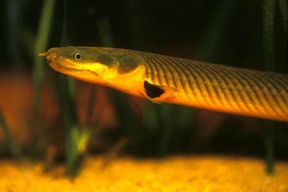Erpetoichthys calabaricus
Ropefish
Classification
Polypteridae
Distribution
Widespread in Western Africa, it’s been collected in Democratic Republic of Congo, Angola, Nigeria, Cameroon, Equatorial Guinea, Benin.
Habitat
Generally inhabits shallow, heavily vegetated waters.
Maximum Standard Length
36″ (90cm)
Aquarium SizeTop ↑
60″ x 24″ x 24″ (150x60x60cm) – 540 litres for an adult specimen.
Maintenance
A densely planted aquarium with a soft substrate and pieces of driftwood forming hiding places is ideal for this fish. A tight-fitting cover is essential as this fish is an excellent escape artist.
Water Conditions
Temperature: 73-86°F (23-30°C)
pH: 6.0-7.5
Hardness: 5-20 dH
Diet
E. calabaricus is carnivorous by nature and will not usually accept dried foods in aquaria, though some specimens have been known to take pelleted varieties. The most suitable options are meaty live or frozen foods such as prawns, earthworms, mussel, bloodworm etc.
Behaviour and CompatibilityTop ↑
Not to be trusted with tankmates it can fit in its mouth but is relatively peaceful otherwise. It can even be maintained in small groups as it is not particularly territorial. Good tankmates include Synodontis species, larger characins and cichlids such as Severum, Angelfish, some Tilapia species etc. It shouldn’t be kept with very vigorous species, however, as it may be outcompeted at feednig time.
Sexual Dimorphism
The male fish has 12-14 dorsal fin rays while the female has only 9-12. When inbreeding condition the anal fin of the male swells and thickens.
Reproduction
Unrecorded in aquaria.
NotesTop ↑
This is the only species in the genus Erpetoichthys, and is an incredibly hardy, nocturnal species. Due to its poor vision, the Ropefish relies on its excellent sense of smell to locate food. It’s closely related to the Polypterus genus and both these are some of the last surviving relatives of very ancient species. Fossils of earlier relatives have been found that date back to the Triassic Period, which occured during the early development of the dinosaurs, more than 200 million years ago.
They have several interesting adaptations. The swim bladder is divided into 2 parts, of which the right hand section is considerably larger. This functions as an accessory breathing organ and means the fish can survive out of water for some time, provided it is kept moist. Like Ananbantoid species, this fish may actually drown if it is denied access to atmospheric air.
Young Ropefish have amphibian-like external gills which are lost as the fish matures. This, coupled with their nocturnal mode of hunting, in which they emerge from their daytime refuges to hunt invertebrates and small fish in shallow water, clearly exhibit the link these species form between fish and amphibians.
Also known as the Reedfish or Snakefish




November 23rd, 2013 at 10:14 pm
Aquarium breeding report ==> http://www.practicalfishkeeping.co.uk/content.php?sid=3121
February 13th, 2017 at 1:27 pm
90cm? All other sources (including fishbase) say 30cm